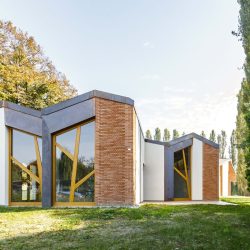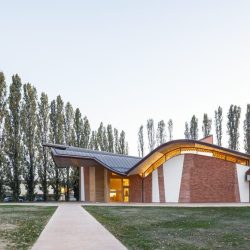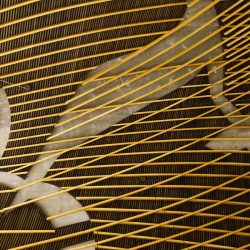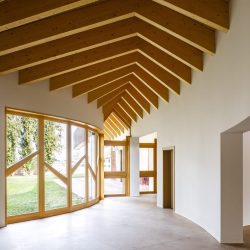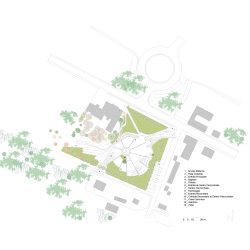
Miralles Tagliabue EMBT . photos: © Marcela Grassi
The ‘San Giacomo Apostolo’ parish complex is a catalyst for the area in which it is located, forming a new nerve center capable of creating identity in the local community and promoting socialization, education and interaction within it.
The building is structured as a kindly and open presence to the inhabitants, thanks to a light and organic architecture that contrasts with the solid and compact materiality of the historical preexistence of Ferrara.
The slender profile of the trees encloses the plot, creating an intimate and familiar environment, in which the building dominates the scene with its sculptural forms, but at the same time dialogues with the surrounding nature thanks to a language inspired by it. This is exemplified in the naturalistic design of the large plaza in front of the church, a natural extension of the church courtyard and at the same time a meeting place: a place of socialization and union that expands the space of the church, opening it up to the town.
Located on a visual and spiritual axis with the new bridge and the city on the other side of the river, access is however made through two lateral routes that join in the design of the square to the church, like two arms open towards community.
The new project includes adjacent spaces that will offer educational, meeting and recreational services to the community, as well as new multifunctional spaces for the adjoining school, with which the parish complex also formally dialogues with a volume attentive to the relationship with its surroundings.
RECOGNITION OF THE SACRED BUILDING
Characterized by its exceptional volume and formal features, the church is immediately perceived as a monumental building that belongs to the public. Its specific function is revealed by archetypal forms and code of formal elements that make its character a sacred building unmistakable.
The undulating shape of the sculptural roof refers to the archetypal vaulted shape of the Romanesque and Gothic naves. However, their parallelism is recomposed into a radial shape and the altar is in the centre from which the parabolic vaults depart.
Similarly, the large entrance portal together with the threshold of the churchyard, marks in a highly symbolic way the entrance to the temple, whose brick and plaster facades underline the assembly character of the interior space.
The facades are made of brick and plaster. The bricks have been specifically worked to present a pointed surface, reminiscent of the famous Palazzo dei Diamanti in Ferrara.
AESTHETIC, FORMAL PROFILE
Like a hot-air balloon delicately placed on the ground, the church presents itself as a light and delicate architecture, fitting into its context as an open and porous element that offers its spaces to the community.
Surrounded by a row of high poplar trees, that create an intimate and unifying space for the meeting of the inhabitants, the building is covered with a light and suspended roof that suggests an upward tension without forgetting the link with nature formalized in organic geometries.
As a solid rotation of the variable section, the church develops radially around a central point occupied by the altar, the building’s real formal and spiritual fulcrum and the huge skylight. The altar is also the focal centre of the church, located on a circular presbytery. Therefore, the classroom, the side chapel, the baptistery, and all annexed spaces are organized around it.
Inside the church, the vaulted and wooden roof implying the naves of medieval churches develops in a radial pattern around a ring of light surrounding a suspended canopy. That shape recalls the shell of St. James.
A large cross of wooden beams flies above the entire nave. The beams, recovered from Ferrara’s old town hall and replaced during the restoration, show a solid and ancient relationship with the city.
Inside, spaces for the sacristy, the parish house, and the conversation room between the faithful and the parish priest continues to develop. In addition, there are aggregative spaces for the community in the low and organic profile volume.
In continuity with the church are the spaces for the sacristy, the parish house and the meeting room for the faithful and the parish priest, while a low-profile, organic volume contains the community meeting areas.
From the main square, the design of the ground leads to these more reserved areas, contrasting public sociality with a more familiar sociality.
LITURGICAL PLANT
The access to the Church is via a large sacred square, and the monumental portal marks the entrance to the Church and the Baptistery. The visible monstrance recovered from the adjacent oratory indicates the central axis towards the altar and the presbytery from the door.
The liturgical space is thus articulated around a central altar located on a circular platform. Both the seat and the ambo are on the altar, as well as the base of the Virgin’s statue, the relic of St. James, the Baptistery, and the monstrance. They are all made of built-in laminated wood, which is made by combining different types of wood.
The room is built semi circularly around it, with curved seats arranged in a radius. The unusual shape allows the faithful to be in close proximity to the altar, promoting a communal celebration.
The central skylight allows light to descend on the altar area, changing the effect throughout the day.
One of the large doors leads to the Baptistery, which is separate but connected to the Aula Eclesiástica’s central area.
The Baptistery has a high, vertical space that is dominated by a 17th century baptismal font.
The relics of St. James are housed in a wooden altar, and another niche dedicated to Marian devotion houses a wooden statue of a Madonna from the sixteenth century, which can be found in the closed Church of the Holy Trinity.
People can enter the weekday chapel, which contains the Blessed Sacrament and is attached to the Church but independent thanks to exterior access designated to it, from the Church’s unitary area.
The sacristy, the penitentiary, and the parish house, as well as the multipurpose classrooms, are all accessible from here.
ARTWORK
Enzo Cucchi’s iconographic concept for the items of art is designed as an organic whole that evolves in the Church’s space.
With the support of Don Roberto Tagliaferri for liturgical interpretation, Enzo Cucchi has placed massive stone crosses on the Church and Baptistery walls.
The enormous grey stone crosses appear to sprout from the rough concrete walls, transforming it into magnificent stone.
Affixed to the crosses are black-coloured ceramic pieces with bas-relief drawings depicting Old and New Testament stories.
The bas-relief and smooth, matte finish of the ceramic help to distinguish the Sacred stories and fill the black artistic work with light.
A Roman cross surrounded by sparkling pieces of coloured ceramic, like an altarpiece, recalls the jewelled cross. In the most primitive era of the Church, the cross was adorned with gems, symbols of stars and planets, saints, angels, and figures sacred to Christianity.
A Via Crucis is formed in the weekday chapel by a series of small crosses made from pietra (stone) serena fragments left over from work on the large crosses in the central nave.
Each bears the number of cross stations in Roman numerals or is modelled in gilded ceramic.
The artistic work takes on highly suggestive forms with symbolic power, where the play of light and shadow accentuates the drama of the space while integrating into the architecture into which it is inserted.
THE SPACES OF THE CHURCH AND THE PARISH COMPLEX
The protagonism of the Church is emphasized in the most prominent location within the parish complex. The altar dominates the central hall inside the Church, receiving light from the skylight’s large luminous eye.
The weekday chapel and baptistery maintain a visual relationship with the altar, forming a separate or unitary space depending on the needs of the individual liturgical moments.
The altar is constructed from a block of white stone from Trani that is almost unworked and has only one polished celebration surface. It is embellished with four small crosses at each corner and has a secret drawer that houses a relic.
The rustic stone’s sides recall the most primitive moments of Christianity when a mass was celebrated with found objects and the location where the symbol took on even greater significance.
Suspended wooden lamps fill the space with soft light, casting shadows that may remind us of the presence of angels. The acoustic ceiling is covered by a wooden cassette with a curvilinear geometry.
The new parish church of St. James fits into Ferrara’s landscape plan, offering a continuity of tradition on the outside and surprising moments of meditation on the inside.
_
Architects: Benedetta Tagliabue – Miralles Tagliabue EMBT
Artist: Enzo Cucchi
Liturgist: Don Roberto Tagliaferri
Structural Design: Studio Iorio, Francesco Iorio



